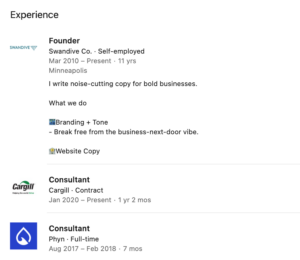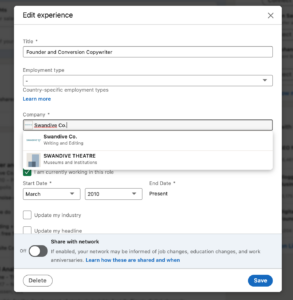Here’s how to list contract work on LinkedIn (it’s a common question, especially now that the workforce is shapeshifting so much!)
I get it. You sit down and mentally prepare yourself to update your LinkedIn profile. You know it’s a must-do if you want your career to make real headway. But you don’t fit the “mold”.
Your experience is varied. You’ve had gigs, side hustles, and contracts.
How do you put all that in a LinkedIn profile? Won’t it look messy and unorganized (not the look you’re going for, I assume)
Here’s how to list contract work on LinkedIn
Listing contract work on LinkedIn takes a little strategy. Here are a few tips and secrets to getting noticed. These are based not only on my experience but also on what I see many profiles doing wrong, on LinkedIn and elsewhere.
Use the “Add Experience” feature
LinkedIn allows you to quickly add experience to your profile. You’ll see the term “add experience” at the top of your profile. Click that.
A drop down will appear giving you options.

Alternate technique – make a company profile
One hack to list contract work on LinkedIn is to leverage the company profile. Why? Well you are a company after all. A lean, hard-working, solo entity providing contract wizardry to companies all over your city.
Plus, company profiles get noticed in the LinkedIn algorithm. Typically contractors, consultants, and freelancers list themselves or their brand under “experience” on LinkedIn and left the company title, job position, and heading blank. If that’s the case, you’re selling yourself short.

Do this instead. Create a company profile.
- Once you’re on LinkedIn, click “Me,” go to “Experience,” click the plus sign, and type “Contractor” as your title.
- From there, you can choose a field and list your specific position, logo, and location.
It’s that easy. And this extra work gives your profile a major credibility boost.
When prospective clients look at your profile, they want to see someone established in a field. This means that by listing your job under experience rather than as an entity like a company, you’re basically saying that you’re not established. Use the company profile to confidently tell them that you are.
Use sample PDFs
If you want to use LinkedIn to generate leads, you know that attractive samples of previous work make all the difference. We want to integrate those samples into your profile to give it a more focused demonstration of your skills.
You can attach PDFs of your previous work directly to your profile under “job history” so that potential clients can always see them. Click “Add on Profile,” then “Featured,” then “Media.”
If you work in multiple industries, you should consider creating separate “experience” sections and adding different samples accordingly. The key to turning your LinkedIn profile into a lead magnet is coherence.
Think of it like telling a story that your prospective clients want to hear. The samples should fit a coherent theme in your profile, one that matches your skills and experience for each industry you work in. Remember that clients are looking for contractors who tell the same story as they do. The right samples show them that you two are a match.
Work the headline
Headlines need to give prospective clients the most accurate, succinct, and compelling keywords possible to tell them what you do. However, here’s a mistake I see a lot of contractors make: they write their headlines to be too optimized.
Headlines need to accomplish two things. They need to tell your clients what you’re about and they need to reassure them that you’re a personable human, not a business algorithm in a human body.
If you over-optimize headlines with keywords, you will actually cost yourself leads rather than gain them. So dump the jargon and the business-speak and tell clients who you are. Throw in the best possible keywords sparingly to seal the deal. The best ones don’t just tell clients what you do – they explain how you can address what clients lack. Identify your clients’ problems and how you address them, but stay personable while you do.
The takeaway for freelancers
At first, LinkedIn may seem more useful for major businesses with real locations and employees. However, freelancers can list contract work on LinkedIn and use it to generate leads just as well, with a little know-how. The above tips represent summaries of major flaws I’ve seen in the average freelancer’s profile and how I would fix them.
By creating a consistent story from your company profile, samples, and headline, you can stand out in a field dominated by algorithms.
As a freelancer, your asset is your individuality. So don’t rely on jargon. Rely on coherence.

